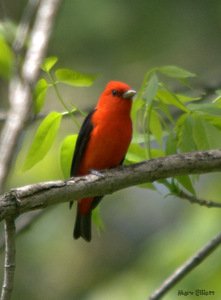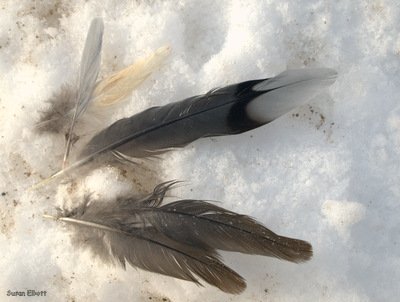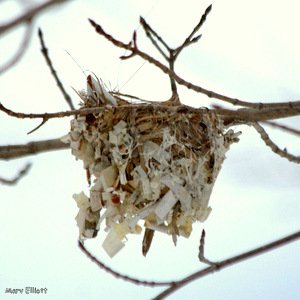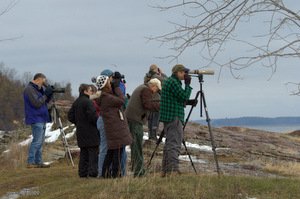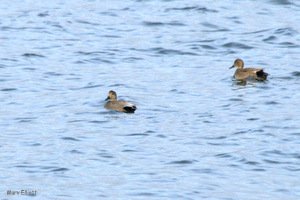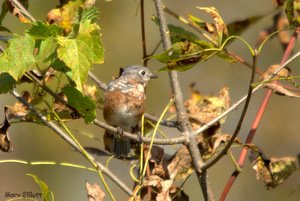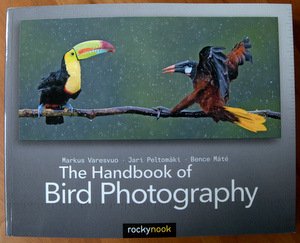 The Handbook of Bird Photography by Markus Varesvuo, Jari Peltomäki and Bence Máté is a recently published tome directing dedicated bird photographers through the in-depth information they need to develop their skills, with the goal of producing exceptional bird photos, whether for documentation or artistic purposes. Equipment and techniques are delineated, but the main emphasis is on field work. Digital image processing and computer manipulations have been left out of the book. Indeed, the authors state that their aim is to present a balanced mix of informative reading and enjoyable viewing. Markus Varesvuo, Jari Peltomäki and Bence Máté, the authors, hail from Scandinavia and Hungary, and the photos are skewed toward that region. Ring Ouzel, Red-flanked Bluetail, Siberian Jay, Eurasian Griffin, Dalmatian Pelican and Western Capercaillie are just a few examples of birds they photographed that are unfamiliar in the Americas. Each of these three authors has won various photographer of the year awards.
The Handbook of Bird Photography by Markus Varesvuo, Jari Peltomäki and Bence Máté is a recently published tome directing dedicated bird photographers through the in-depth information they need to develop their skills, with the goal of producing exceptional bird photos, whether for documentation or artistic purposes. Equipment and techniques are delineated, but the main emphasis is on field work. Digital image processing and computer manipulations have been left out of the book. Indeed, the authors state that their aim is to present a balanced mix of informative reading and enjoyable viewing. Markus Varesvuo, Jari Peltomäki and Bence Máté, the authors, hail from Scandinavia and Hungary, and the photos are skewed toward that region. Ring Ouzel, Red-flanked Bluetail, Siberian Jay, Eurasian Griffin, Dalmatian Pelican and Western Capercaillie are just a few examples of birds they photographed that are unfamiliar in the Americas. Each of these three authors has won various photographer of the year awards.
The professional bird photographer will be the one who finds this book most valuable. At that level, equipment includes a high-end DSLR camera in the $6,000-$8,000 range. (Semi-professional cameras can be had for $1,000-$4,000, whereas amateur DSLRs will only cost you $600-$1,600.) Truly dedicated bird photographers pack two DSLR cameras in their bags: one with a wide-angle lens for bird flocks, and a second with a telephoto lens for close-ups. Additional technical chapters give highly detailed discussions of sensors, lenses, telephoto extenders, continuous high-speed shooting, exposure, light metering, etc.
To the average bird enthusiast, all of this sounds very haughty, but it is essential knowledge to creating breathtaking award-winning photos. Even so, the authors recognize the proper place of precise technical skills, for they repeatedly state that the most aesthetically pleasing bird photos are grounded in following several general rules of thumb which can be practiced by any photographer. Foremost, knowledge of bird behavior and biology will improve your photography; the best photos are the result of spending long stretches of time with one species. Experience in the field, and viewing field conditions, as well as the bird, is prime. Photographers should let birds approach them and not vice versa (birds will move away). In this vein, all three authors strongly suggest using a blind. Although the book illustrates several elaborate settings, their point is that any good coverage is an immense help, as well as subdued or camouflage clothing. Also, it is well to remember that headwinds are better for photographers than birds flying with a tailwind because a headwind forces the birds to fly closer to the earth’s surface.
Reading through the book, as a ‘newbie’ myself in the leap from 35 mm to digital photography, I began to understand that the way to improve your photos is to progress from a reactive “point and shoot” photographer, to one who plans to capture a subject utilizing whatever limited (and hopefully increasing) skills one has to, to proactively create a good shot. And though the book gives insider tips for stunning scenes (migration across the sheen of the aurora borealis, anyone?), there are plenty of practical, simple tips for photographing in mist, fog, falling snow - and that bane of all nature photographers – when your subject is just behind a prominent branch. Getting beyond point and shoot requires looking for new angles and adding a little bit extra: the light of a beautiful evening, dramatic backlighting, or an interesting background. Creating a controlled, simulated setting need not be so involved that it is best left to the professional. Anyone can set out berries or dead rodents as a lure. And there is a way to install a small mirror at a bird bath to give nice backlit features.
Lastly, it is probably the undefinable that results in the greatest photos. It is an inner aesthetic receptiveness to the beautifully enticing: that which the photographer perceives without technical or site manipulation. My favorite photo (page 27) is of Red Phalarope gingerly stepping through a pool or red reflective water. The photographer had been taking various close-ups of the phalarope when he suddenly noticed that his travel partner had moved to a position such that his bright red feathers were making interesting patterns of deep red way reflections right around the bird.
The $50 price for this book (358 pages) is somewhat daunting. But from my amateur’s viewpoint, this is an extremely valuable addition to the professional’s reference shelf. For the amateur, there is still a lot of useful material to start working with to begin moving beyond common frustrations and toward more satisfying photos. And for the rich and famous with no prior bird interest, you could spend $50 on a lot less healthy things to lift your mood. The photos are exquisite, and you’ll spend a few hours transporting your mind through ethereal realms of nature’s beauty.
(In the interest of full disclosure, RCAS was given a free copy of this book provided we would give a public book review. The above represents my honest opinion of the book, and I have not received any personal compensation in preparing this review).
For a list of other books we’ve reviewed, click here.
 a Pied-billed Grebe on its nest
a Pied-billed Grebe on its nest